 First match: 15 May 1956 – Canberra
First match: 15 May 1956 – Canberra
South Africa 41 / Australian Capital Territory (ACT) 6
Promoting rugby union was paramount in Australia when the Springboks arrived in 1956. Consequently -soon after arrival- at a civic reception at the Sydney Town Hall Danie Craven and Basie Viviers promised to play open attractive rugby to help rugby union in their battle for player volume against rugby league.
The team travelled to Canberra for the first match against an Australian Capital Territory team. This match was not part of the original tour itinerary and was arranged as a tribute to the resolute efforts of local administrators to gain footing for union rugby in an area with a population basis slightly bigger than Paarl in Cape Province, South Africa.
Craven and the Springboks did not mind the additional game; it provided an ideal pipe-opener for the hard New South Wales game in Sydney only four days distant.
It was an opportunity to assess strengths and weaknesses against a side with only two players of note namely the wing P Morton and the flyhalf K.E Hawke. The vice-captain of the ACT side was a South African Daan Olivier. Olivier turned out to be a more than useful lock.
Wilf Rosenberg aggravated his hamstring injury during training in preparation for this match. This injury which Rosenberg picked-up during a lengthy first practice session after the team assembled in South Africa ruled Rosenberg out of the Australian part of the tour. Rosenberg hamstring was the first of a series of injury misfortune that plagued the 1956 side. Rosenberg in the end played only in 5 matches (out of a possible 6 in Australia and 23 in New Zealand). By comparison James Starke and Theuns Briers -who were called-up later as injury replacements-, played 3 more games than Rosenberg. Brain Pfaff was another player who featured in only 5 matches during the entire tour while Jan du Preez played a total of only 6 (2 in Australia and 4 in New Zealand). Other players dogged with injury were Johnny Buchler – 8 matches (4 each in NZ and Australia) and Melt Hanekom – 9 matches (3 in Aussie and 6 in NZ). Also tormented with injuries as the tour progressed were Ian Kirkpatrick, Roy Dryburg, Basie Viviers and Pat Montini. Basie van Wyk played in no game at all after fracturing his tibia just below the knee during practice just before the second tour match against New South Wales.
The Springboks selected all of their newcomers for this opening match. The team was: Johnny Buchler; Jan du Preez; Basie Viviers (Capt); Jeremy Nel; Roy Dryburg; Bennett Howe; Coenraad Strydom; Harry Newton-Walker; Melt Hanekom; Piet du Toit; Chris de Wilzem; Salty du Rand; Jan Pickard; Butch Lochner; Daan Retief.
The ACT team was: D Gilroy; P Morton; PM Meere; NT Hanesen; J Gallagher; KE Hawke (Capt); JW Maguire; G Kaye; C Koerber; RF Wiley; WE Keeley; M Burke; DP Olivier; J Maguire; K Faint.
The game resembled all the characteristics of a tour-opener; dropped passes; halfbacks being unsynchronized with the rest and too many players trying to do too much on their own. The team as a consequence had real difficulty establishing a rhythmical and consistent attack.
The home-side was however no match for the Springboks and the backline ran in seven sparkling tries. It was not a convincing performance but there were nevertheless encouraging signs from the 41-6 victory like a general alertness to attacking possibilities mostly by the two wingers Jan du Preez (3 tries) and Roy Dryburg (2 tries) as well as Jeremy Nel -who scored the first try of the tour- and the halfbacks Strydom and Howe.
Reg Sweet in his book ‘Kiwis conquer’ wrote: ‘None was more alive to his chances than Jan du Preez on the left wing, and all three his tries were gained in splendid style. Du Preez used his pace and more swerve than had seen him demonstrate before, and quickly established himself as a firm favourite with the crowd.’
Basie Viviers playing outside centre had a captain’s innings with a remarkable run of place-kicking precision which would characterise most of his appearances in Australia. Viviers’ 18 points in this match included a try which resulted when he followed-up at pace on a short punt to the corner flag by Bennett Howe.
ACT wing Morton lived up to his reputation but Roy Dryburg escaped his attentions twice for his two tries and added a penalty and a conversation to the overall score.
Jeremy Nel got the honours of scoring the first try of the tour and was ‘borselled’ afterwards for this achievement.
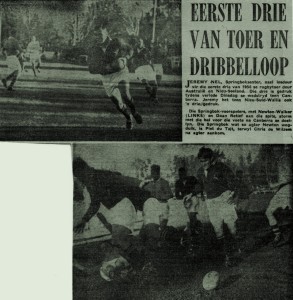
This picture shows Jeremy Nel going over for the first try of the tour
The following article featured in one of the local newspapers about the Springboks ‘borsel’ tradition.
| Sunday Telegraph, Sydney, Australia, 6 May 1956 ‘Schoolboy’ beatings for Springboks training defaulters It’s a borsel for the “dorsal”From Wally Crouch | |
| CAPETOWN, Sat. — South Africa’s Rugby players arrive in Sydney soon — with a dark secret.The thing about which the Springboks hope their Australian hosts won’t ask embarrassing questions is called a borsel.It’s a heavy clothes-brush, sometimes laid across the rear anatomy of players who are unpunctual or play up at practice.This medieval form of punishment, plus degrading initiation ceremonies players are often forced to undergo, demonstrates the serious zeal with which South Africans take their “rugger” — off, as well as on, the field.
The borsel is an old Rugby institution — it was used on the 1931 and 1951 Springbok tours of England. Now, however, this disciplinary measure has come under fire from sports writers in South African newspapers. |
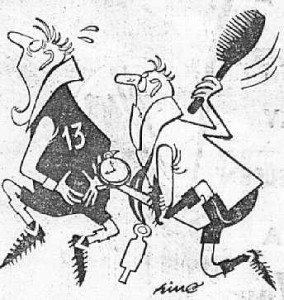 |
| “Undignified and puerile”Thundered the Johannesburg Sunday Express: “Has not the time come to abolish ‘initiation’ ceremonies and the borsel?”They are unpleasant, they are undignified, and above all they are puerile.”Our Springboks, after all, are not boys from prep school. They are grown men; and they are doing neither themselves nor other Rugby players any good by constantly resorting to this ridiculous piece of by-play.”
But tradition dies hard. When questioned as to whether he would ban the initiations and the borsel, Dr. Danie Craven, who is both president of the South African Rugby Board and manager of the touring team, snapped back: “No decision can be made about this matter unless it comes up officially.” The borsel practice in recent years, say some sports writers here, has been getting out of hand. Some men have been beaten black and blue, others have broken down and wept after beatings. Likewise, they claim, the threat of the borsel has caused off-the-field horseplay to invade South African Rugby. So-called initiation ceremonies, once innocuous, have now taken a brutal and violent form. Some players have been subjected to scandalous indignities. One writer quotes the case of three men new to provincial Rugby who were locked in a train compartment while their initiators went to the train’s bar and stoked up on liquor. Later, in another compartment, one of the three, a six-foot forward, was held and beaten viciously with a leather strap torn from one of the train’s sleeper bunks. The huge man broke down. |
|
For ACT Dave Gilroy kicked a penalty and Maguire the scrumhalf scored a try.
Mr JK Uys the South African High Commissioner in Canberra held a reception that night for the Springbok team. The reception was attended by hundreds and amongst those guests were Rugby League scout, Ray Stehr. Prowling like a hyena, this famous Ex-Rugby League player was scavenging for new talent. That night, he offered Bennett “Pee-wee” Howe £4 000 in cash, a free passage to England and a job on similar salary as his current one to sign for club in the North of England. Howe declined. Later he tried Jeremy Nel and Jan du Preez who also said ‘no thanks’ but the league scouts eventually had some sterling success. By the end of the tour – to the dismay of SA rugby fans – the darling of SA rugby Tom van Vollenhoven as well as the fleet footed Wilf Rosenberg was converted. Van Vollenhoven is to this day remembered in England rugby league circles as one of, if not the finest wingman ever (click here to see van Vollenhoven in action).
Second match: 19 May 1956 – Sydney
South Africa 29 / New South Wales 9
This match attracted much attention due to the famous victory of the New South Wales team over the 1937 Springboks. The Springboks were expecting a hard game and Craven was a bit concerned as this remark quoted in one of the newspapers illustrate: “Although this is a match against a Sate side we consider it will be a very hard game. I would not forecast the result. My players are not yet up to top match standard, and this can only come later in the season.”
The Springboks selected what they considered to be their best 15 for the match. The team was: Viviers (Capt); van Vollenhoven; Nel; Kirkpatrick; Johnstone; Pfaff; Strydom; Bekker; van der Merwe; Koch; Ackermann; du Rand (Vice-capt); Claassen; Lochner; Retief.
The New South Wales side included most of the Wallabies that played against New Zealand in 1955. The team was: Phelps; Stapleton; Phipps; Potts; Morton; Summons; Burke; Shehadie; Brown; Davidson; Thornett; Cameron (Capt); Miller; Cross; Hughes. The referee was Dr. I.R Vanderfield.

New South Wales winger Alan Morton getting tackled by Paul Johnstone in this match
Misfortune forced the team to dig deep for this particular match. Bertus van der Merwe received word the day before the match that his son had died; Basie van Wyk broke his leg in practice on the same day; Rosenberg was out with a hamstring injury; Ulyate the incumbent test flyhalf was also injured. To crown it all Kirkpatrick fractured his scapula in the first minutes of the game forcing the team to complete the match with only 14 players.
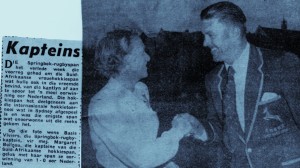
The South African female hockey team was playing in an international tournament in Sydney at the time of the Springbok rugby teams visit. Ian Kirkpatrick sister was playing for the SA hockey team and she met up with Kirkpatrick soon after the ‘boks arrival in Sydney. The Springbok team attended one of the matches and this picture shows Basie Viviers congratulating Margeret Boileau the captain of the South African hockey team with her team’s 1-0 victory over the Netherlands.
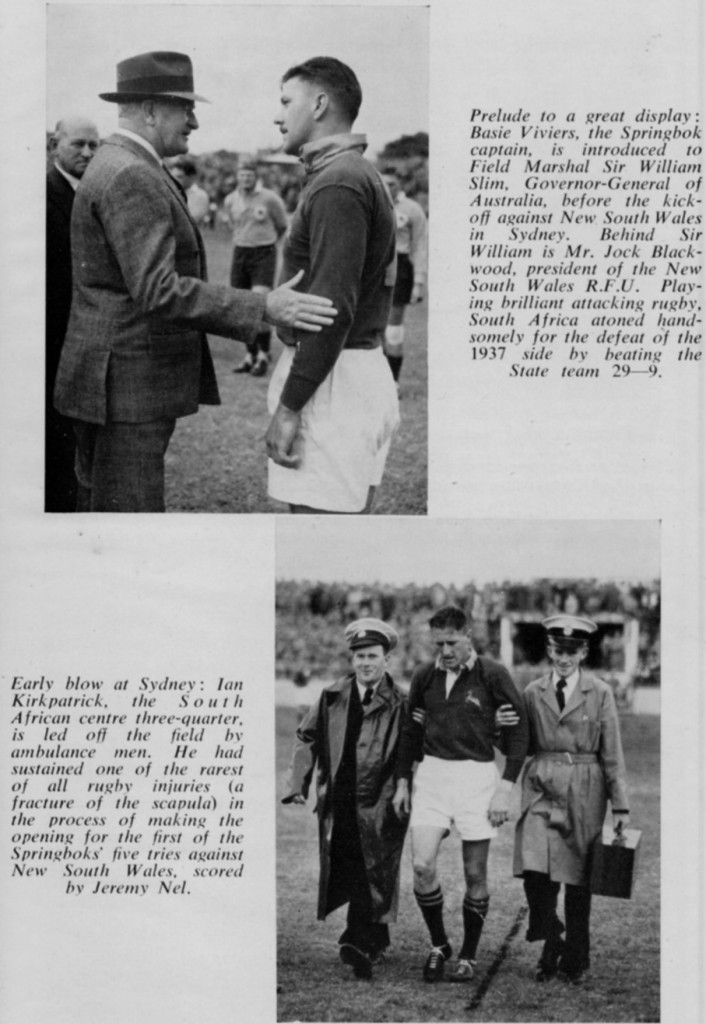 The top of these two pictures shows Basie Viviers being introduced to the Governor-General of Australia before the start of the second tour match against New South Wales. The bottom picture shows Ian Kirkpatrick being led off the field after fracturing his scapula early in the match. Kirkpatrick created the first Springbok try in this match by Jeremy Nel with a clever corner kick. He was crash-tackled by Jack Potts while in the act of executing the kick.
The top of these two pictures shows Basie Viviers being introduced to the Governor-General of Australia before the start of the second tour match against New South Wales. The bottom picture shows Ian Kirkpatrick being led off the field after fracturing his scapula early in the match. Kirkpatrick created the first Springbok try in this match by Jeremy Nel with a clever corner kick. He was crash-tackled by Jack Potts while in the act of executing the kick.

These three pictures is almost a forecast of the 1956 tour. The top picture shows the NSW forwards rushing through the line-out and putting pressure on scrumhalf Coenraad Strydom forcing the nippy little halfback to kick. South Africa’s line-out jumpers was competitive and superior against most teams in both Australia and New Zealand. The pack lacked structure and cohesive forward drive once the ball was caught and they were often pushed backward (or static). New Zealand coaches were quick to identify and exploit this flaw. Rushing through the line-out to eliminate the two excellent South African half backs –and as a consequence the dangerous South Africa backs- became a national strategy against the ’56 Springboks. Pressure on the halfbacks was one of the main stratagems used in particularly the third and fourth test matches by the All Blacks. The bottom picture on the left shows Coenraad Strydom on the break; he and Tommy Gentles (the other scrumhalf on tour) were always dangerous when allowed any space. The bottom picture on the right shows Jeremy Nel who scored the opening tries in both the first and second tour matches. The wet grounds in New Zealand suited the strong and muscular Nel and he was one of the stars of the tour.
After an early Springboks try by Nel –during which Kirkpatrick got injured- Lochner moved to centre. This allowed the NSW pack to dominate proceedings for the last 20 minutes of the second half against the 7 man springbok pack. Lochner, however, stemmed the tide with a devastating display of tackling in the backline reminiscent of his performance for Western Province Universities against the 1953 Wallabies when he also transferred to the backs under similar circumstances. The NSW forward dominance eventually paid off when the Springboks got penalised for holding on to the ball on the ground 5 meters from their goal line. The penalty was converted into points. Minutes later NSW forced another ruck 5 meters out and Burke dived right over the ruck to score a sensational try. Leading 8-6 at halftime and with New South Wales having missed with 4 penalty attempts the Springboks looked in trouble and visions of a repeat of the 17-6 defeat in 1937 were eminent.

This picture shows Burke scoring the NSW try. Burke apparently dived over a ruck to score the try
The game however was too early in the season for the home team and a complete change came over the match in the second half with the NSW pack tiring. Du Rand and Claassen started to assert themselves in line-outs and with ball in hand. Van der Merwe continued to hook his ball in the scrum and the Springboks started to get front foot ball.
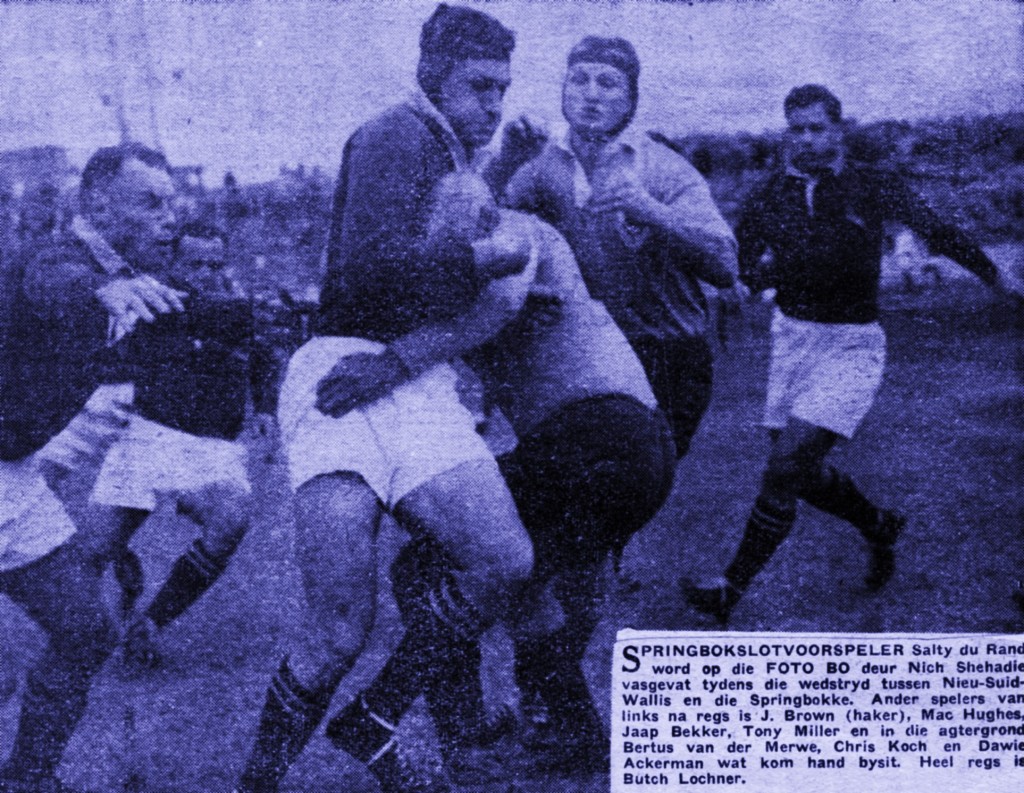
The Springboks forwards came into the game with the second half. This picture shows a rampaging Salty du Rand. It was this sort of aggressive forward play that created the necessary forward momentum that allowed Pfaff and Strydom to get the backline going
Brian Pfaff in his first game for the Springboks played well and evidenced good decision making, faultless handling and breaking to good effect. Strydom and the loose forwards also came more and more into the game as it progressed culminating into four splendid Springbok tries in the second half (Retief, van Vollenhoven (2) and Strydom). The Springboks eventually won convincingly 29-9 after Viviers succeeded with 3 conversions and a second penalty goal.
Strydom and van Vollenhoven had outstanding performances and become almost instantaneous celebrities in Australia. The man of the match was however Butch Lochner. Terry Mclean asserts that it was impossible to disabuse one’s mind of the thought that “Butch” Lochner was the man of the match. He narrates how Lochner was crash-tackling Potts and Phipps out of the match during the last 20 minutes of the first half when their forwards were stern, virile and exciting. It was the demoralising crash-tackling of Lochner on the NSW centres that eventually created the opening for the backs in the opinion of McLean. He writes:
It was here in the midfield, that New South Wales so embarrassingly fell away in the second half and an avalanche of Springboks for the greater part of the game hurled itself onwards. Phipps, it was said, was mildly concussed by one of Lochner’s tackles. Potts, it was quite plain, was but a tremulous beginner in such critical occasions and circumstances. And it was into the hole that, in particular, Phipps left that Nel made such trusts that van Vollenhoven scored two tries and the NSW forwards of necessity endured the disagreeable experience of too often moving backwards and too seldom forward.

Picture showing Daan Retief scoring the first of the springboks 4 second half tries against New South Wales. Retief’s try resulted from a splendid exhibition of ball handling by the Springbok forwards. It was Ackermann that started it when he picked up a ball dribbled by Bekker into the NSW 25. Koch came up fast on his right in support and received the ball. The Springbok prop running strongly drew the last defender as neatly as any back and send Retief over for his try.
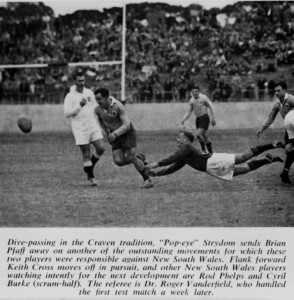
This picture shows Coenraad Stydom dive passing in the Craven tradition. Not only was Strydom outstanding with his clearance of the ball -throwing long accurate passes- but he started the last van Vollenhoven try with a great break from the flyhalf position when Pfaff moved into the No9 role to clear the ball from a quick forming ruck.
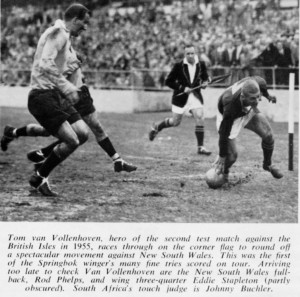
Tom van Vollenhoven scoring one of his two tries against New South Wales (NSW). Both the van Vollenhoven tries resulted from quick phase play and some excellent running and splendid timed passing by the inside backs to create the necessary space for the winger to outpace the defence.
One of Australia’s leading rugby writers said to Reg Sweet after the match: “This is one of the finest exhibitions of fast, open rugby we have seen since the war –better even than that of the 1950 British Isles side, and we thought they were great”.
This one is a bit of a step back in time in terms of my series on the 1956 tour. I recently found some more info on the Australian leg of this tour so I thought I’ll step back and do a couple of posts on the Australian matches.
This is excellent, thanks!!
@ Gena_ZA:
Thanks for the feedback. Glad you enjoyed it.
Good editorial job GBS. Looking good.
4 @ McLook:
Thanks for the history article McLook. Always enjoy reading them.
@ Puma:
My pleasure Sir.
Users Online
Total 67 users including 0 member, 67 guests, 0 bot online
Most users ever online were 3735, on 31 August 2022 @ 6:23 pm